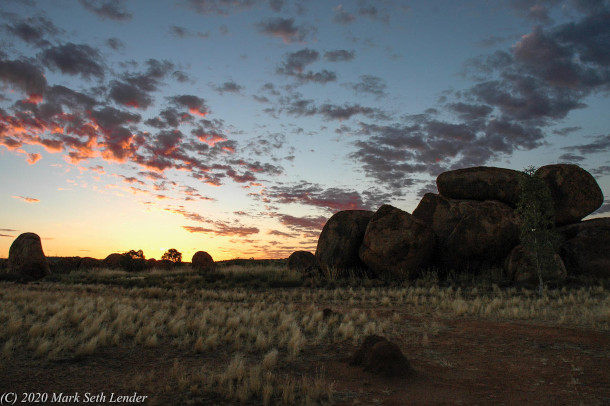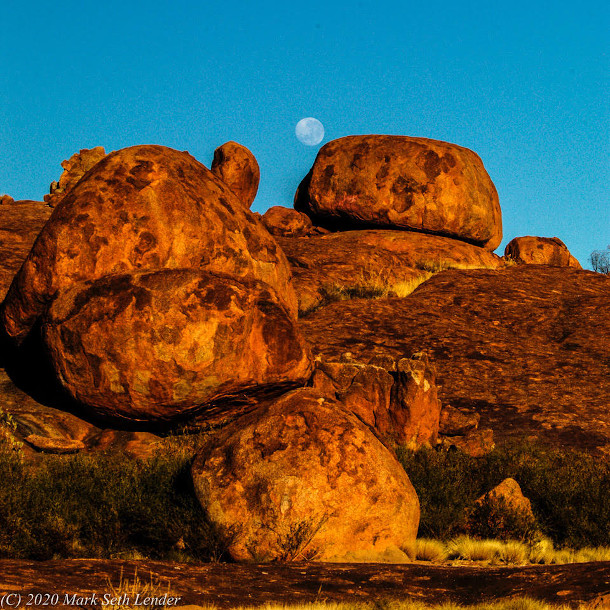The Road To Darwin
Air Date: Week of December 4, 2020

A sunset off the highway on the road to Darwin, Australia. (Photo: Mark Seth Lender)
Living on Earth's Explorer in Residence Mark Seth Lender tells of his and his wife's encounter with a black panther while driving along Australia's Stuart Highway.
Transcript
DOERING: Australia is full of wonderful and strange animals. From salt water crocodiles and turtles that breathe through their behinds to the duck billed platypus, a mammal that lays eggs. For all its oddities the island country isn’t home to any native big cats. But rumors of sightings have circulated since the 1800s and Living on Earth’s Explorer in Residence, Mark Seth Lender, recently had a close encounter of his own.
The Road to Darwin
Driving north on the Stewart Highway, (two lanes straight as an arrow) the tarmac belongs to the Road Trains. Three and four trailers 120 metric tons each one, cruising at 130 clicks, cab the size of a locomotive – they are of a speed and configuration making it impossible for a Road Train to turn. Valerie and me, we give Road Trains the full width of the road, pulling halfway off onto the dirt shoulder as soon as we spot them, deliberately sending up a cloud of dust to let them know.
They blare their horns and wave and we wave back. The shockwave rattling the camper van as they push on through.

Karlu Karlu, also known as the Devils Marbles, a collection of gigantic stone boulders seen as one of the most recognized symbols of the Australian Outback. (Photo: Mark Seth Lender)
The sun is careening towards the horizon, and the distant mountains still no closer than they were this morning in this vast and timeless place. Nothing not even a Road Train will travel here in the dark. Cow country. Unfenced. The cows wander out into the middle of the highway... At night, you won’t see them. We start looking for a turnout.
Soon enough we find our camping place, a clearing beside the road. We lay back. Look up. An unfamiliar sky unfolds; the Southern Cross with its blazing stars the one thing unmistakable.
In the morning up with the sun we push on, finally stopping for lunch at the marker for the Tropic of Capricorn. Just to say we did. And take pictures. Just to prove it. And on our way again.
Not ten minutes after, Valerie in a quiet voice says, “Look… ”

Mark Seth Lender stands at a marker of the Tropic of Capricorn. (Photo: Mark Seth Lender)
Unmistakable as that Southern Cross, a black panther crossing the road.
He glances at us - barely - as if we are a familiar sight.
Doesn’t run.
Doesn’t grant us a second look.
And in his casual cat-like cadence slips into the underbrush and turns, parallel to the road for a dozen meters more -
And disappears.
We have seen a thing of legend. Rumored. Unconfirmed. Object of conjecture. Of ridicule. And yet, all that a panther is rare to the point of disbelief he treated us like something unremarkable and, of no importance.
Things come. Things go. Like Road Trains and dust. Black panthers remain. To them, we and our age of industrial scale and speed, we are the creatures of myth, the ones who do not exist. Or if we do, in their timeless view? A passing fancy.
DOERING: That’s Living on Earth’s Explorer in Residence, Mark Seth Lender.
Links
Living on Earth wants to hear from you!
Living on Earth
62 Calef Highway, Suite 212
Lee, NH 03861
Telephone: 617-287-4121
E-mail: comments@loe.org
Newsletter [Click here]
Donate to Living on Earth!
Living on Earth is an independent media program and relies entirely on contributions from listeners and institutions supporting public service. Please donate now to preserve an independent environmental voice.
NewsletterLiving on Earth offers a weekly delivery of the show's rundown to your mailbox. Sign up for our newsletter today!
 Sailors For The Sea: Be the change you want to sea.
Sailors For The Sea: Be the change you want to sea.
 The Grantham Foundation for the Protection of the Environment: Committed to protecting and improving the health of the global environment.
The Grantham Foundation for the Protection of the Environment: Committed to protecting and improving the health of the global environment.
 Contribute to Living on Earth and receive, as our gift to you, an archival print of one of Mark Seth Lender's extraordinary wildlife photographs. Follow the link to see Mark's current collection of photographs.
Contribute to Living on Earth and receive, as our gift to you, an archival print of one of Mark Seth Lender's extraordinary wildlife photographs. Follow the link to see Mark's current collection of photographs.
 Buy a signed copy of Mark Seth Lender's book Smeagull the Seagull & support Living on Earth
Buy a signed copy of Mark Seth Lender's book Smeagull the Seagull & support Living on Earth

